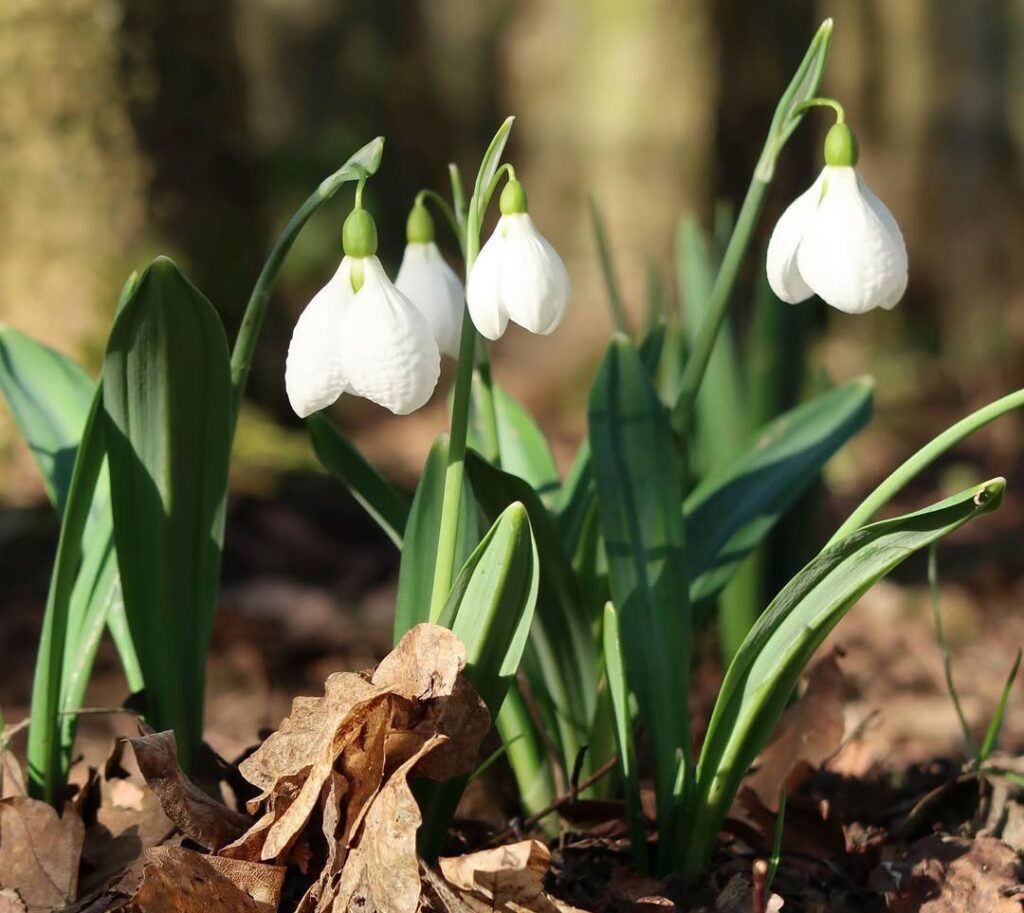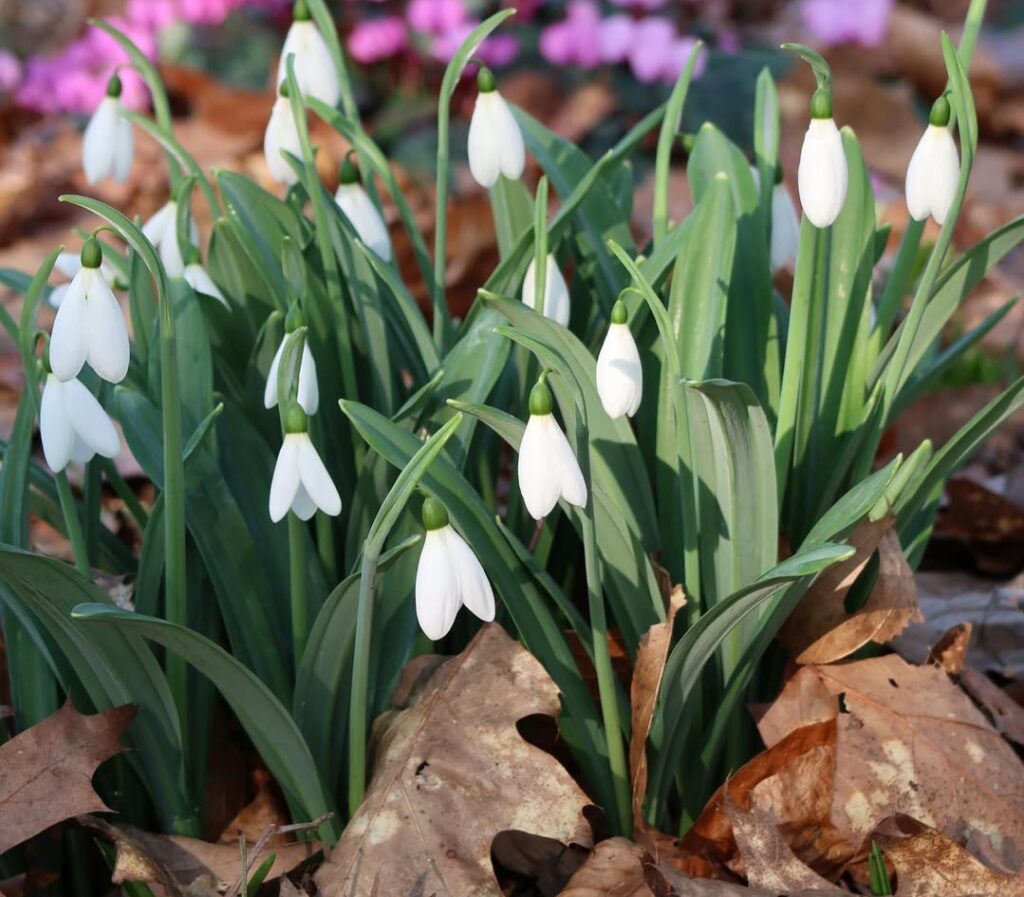Snowdrop flowers, with their delicate white petals, are among the first flowers to bloom each year, often appearing when the last traces of winter are still lingering. These charming flowers symbolise purity, renewal, and hope, making them a popular choice for gardens worldwide. Whether you’re an experienced gardener or a beginner, growing and caring for snowdrops is a rewarding experience. This comprehensive guide will walk you through everything you need to know to successfully grow snowdrops in your garden, from planting to maintenance and even how to propagate and protect them through the colder months.

- 1 1. Introduction to Snowdrops
- 2 2. Quick Facts About Snowdrops
- 3 3. Snowdrop Care
- 4 Light
- 5 Water
- 6 Temperature and Humidity
- 7 Soil
- 8 Fertiliser
- 9 4. Common Problems, Pests, and Diseases
- 10 Bulb Rot
- 11 Pests
- 12 Diseases
- 13 5. How to Plant Snowdrop Bulbs
- 14 Timing
- 15 Planting Depth and Spacing
- 16 Choosing the Right Location
- 17 6. Pruning and Maintenance
- 18 Deadheading
- 19 Foliage Care
- 20 Mulching
- 21 7. Propagation Snowdrops can be multiplied using either seeds or bulbs.
- 22 Bulb Division
- 23 Seed Propagation
- 24 8. Overwintering Snowdrops
- 25 9. Growing Snowdrops in Containers
- 26 Container Care
- 27 Winter Care
- 28 10. Repotting Snowdrops
- 29 11. Popular Snowdrop Varieties
- 30 FAQS
1. Introduction to Snowdrops
Snowdrops (Galanthus spp.) are small, bulbous plants known for their early spring bloom. Their distinctive white flowers, which resemble teardrops, often emerge from the snow, signalling the end of winter and the arrival of spring. These hardy little flowers thrive in cold climates and are a favourite among gardeners for their ability to bloom early in the year.
In addition to their beauty, snowdrops are rich in symbolism. In many cultures, they are associated with renewal, purity, and the hope that spring brings. Because they are often the first flowers to bloom after the harsh winter months, they are viewed as a sign of resilience and new beginnings.
2. Quick Facts About Snowdrops
Before we dive into the specifics of growing and caring for snowdrops, here are a few key facts to help you get to know these flowers better:
Botanical Name: Galanthus
Size: Snowdrops typically grow to about 4 to 6 inches in height.
Sun Exposure: They like partial sun better than full sun.
Soil Requirements: Well-drained, moist soil that is rich in organic matter.
Hardiness Zones: Snowdrops are hardy in USDA zones 3-9.
Best Planting Time: Fall is the ideal time to plant snowdrop bulbs, as it allows the bulbs to establish roots before the colder months.
3. Snowdrop Care
Once you’ve planted your snowdrop bulbs, proper care is essential to ensure they thrive and return year after year. Here’s what you need to know about their growing conditions and ongoing maintenance:
Light
Snowdrops prefer bright, indirect light or partial shade. In areas with mild winters, they can tolerate more direct sunlight. However, in warmer regions, too much sunlight can dry them out. If you live in an area with hot summers, it’s best to plant snowdrops in a spot that receives dappled sunlight or afternoon shade.
Water
These flowers like moist, but not soggy, soil. Ensure the planting area drains well to prevent water from accumulating around the bulbs, which can lead to rot. While snowdrops don’t need a lot of water, they appreciate a good soaking during dry spells, especially during their active growing period in early spring.
Temperature and Humidity
Snowdrops are cold-hardy flowers that can withstand temperatures well below freezing. They are ideal for gardeners in cooler climates, as they thrive in USDA zones 3-9. Snowdrops require a cold winter to perform well, as the chilling period triggers their growth cycle. In warmer areas, where winters aren’t cold enough, they may struggle to grow and bloom as vigorously.
Soil
Snowdrops prefer neutral to slightly alkaline soil, but they can tolerate a wide range of soil types. The key is to ensure the soil is well-draining and rich in organic matter. If your soil is clay-heavy, consider adding compost to improve drainage.You can raise the pH of the soil by adding lime if it is excessively acidic.
Fertiliser
Snowdrops generally don’t require heavy feeding, especially if your soil is rich in organic matter. However, a light application of balanced fertiliser in the fall can encourage better growth. Avoid excessive fertiliser, as it may encourage lush foliage growth at the expense of flowers.
4. Common Problems, Pests, and Diseases
While snowdrops are relatively low-maintenance, they can be susceptible to a few common problems, pests, and diseases:
Bulb Rot
The most significant threat to snowdrops is bulb rot, which occurs when the bulbs are planted in poorly drained soil or receive too much water. To avoid this, make sure your planting site has excellent drainage, and do not overwater.
Pests
Snowdrops are generally pest-resistant, but some animals like deer and rabbits may occasionally nibble on the delicate flowers. If you notice damage, consider using repellents or physical barriers like fencing to keep pests away.
Diseases
Snowdrops are not typically prone to many diseases, but they can occasionally suffer from fungal infections such as botrytis blight or mildew. To prevent this, make sure your plants have good air circulation and are not overcrowded. Remove any dead or diseased foliage promptly to avoid spreading infection.
5. How to Plant Snowdrop Bulbs
Planting snowdrop bulbs is a simple process that will reward you with beautiful flowers in early spring. Here’s a step-by-step guide to planting snowdrops:
Timing
The best time to plant snowdrop bulbs is in the fall, before the first frost. This allows the bulbs to establish roots and prepare for winter dormancy. If you’re planting in the spring, you’ll need to refrigerate the bulbs for a few weeks before planting to mimic winter conditions.
Planting Depth and Spacing
Plant snowdrop bulbs about 2 to 3 inches deep and 3 to 4 inches apart. They thrive in clusters, so plant multiple bulbs together to create a stunning display. Planting them deeper may cause them to have trouble emerging, while planting too shallow may expose the bulbs to frost.
Choosing the Right Location
Snowdrops do well in a variety of locations, including woodland gardens, under trees, or along borders. They look beautiful when planted among low-growing plants like crocuses or hellebores. Choose a spot that provides partial shade and is protected from strong winds, as snowdrops have delicate flowers that can be damaged by gusty weather.
6. Pruning and Maintenance
Snowdrops are relatively low-maintenance, but there are a few things you can do to keep them looking their best:
Deadheading
While it’s not necessary to deadhead snowdrops, removing spent flowers will prevent them from going to seed and redirect the plant’s energy into producing more bulbs.
Foliage Care
After blooming, snowdrop foliage should be left alone to die back naturally. Do not cut the leaves prematurely, as they are necessary for photosynthesis, which helps the plant store energy for next year’s growth. Once the leaves turn yellow and wither, you can trim them back to the base.
Mulching
If you live in an area with harsh winters, mulching can help protect the bulbs from freezing. Apply a light layer of mulch, such as shredded leaves or straw, to insulate the bulbs during the coldest months.
7. Propagation Snowdrops can be multiplied using either seeds or bulbs.
Bulb Division
The most common method of propagation is dividing snowdrop bulbs. After growing for a few years, the bulbs will clump together on their own. You can dig up the clumps, carefully separate the bulbs, and replant them in a new location. This is best done after the flowering season, once the foliage has died back.
Seed Propagation
Snowdrops can also be grown from seeds, though it’s a slower process. Harvest seeds from the spent flowers and sow them in a seed tray or directly into the garden. It may take several years for seed-grown snowdrops to mature and bloom, so be patient!
8. Overwintering Snowdrops
Snowdrops are extremely cold-hardy and can survive even the harshest winters. However, in areas with heavy snow or fluctuating temperatures, it’s a good idea to apply a layer of mulch to protect the bulbs from extreme cold. The mulch helps maintain a stable temperature and prevents the bulbs from freezing.
If you live in a region where winters are milder, snowdrops may need extra protection. In containers, you can bring them indoors or place them in a sheltered location.
9. Growing Snowdrops in Containers
While snowdrops are traditionally grown in the ground, they can also thrive in containers. Growing snowdrops in pots allows for more control over the growing environment and makes it easier to protect the plants during the winter months.
Container Care
Choose a container with good drainage and use well-draining soil. Snowdrops don’t like to sit in waterlogged soil, so be sure to plant them in pots that allow excess water to escape. Water the bulbs regularly, but avoid overwatering. After they’ve finished flowering, let the foliage die back naturally, just like you would in the ground.
Winter Care
In colder climates, place container-grown snowdrops in a sheltered spot, such as a porch or garage, during the winter. Alternatively, you can bury the pot in the ground for extra insulation.
10. Repotting Snowdrops
Repotting snowdrops every few years can help refresh the soil and give the bulbs more space to grow. If your snowdrops are overcrowded, divide them during the repotting process to prevent them from becoming root-bound. Repot in the fall after the flowers have faded and the foliage has died back.
11. Popular Snowdrop Varieties
There are many different varieties of snowdrops, each with its unique characteristics. Some of the most popular include:
Galanthus nivalis: The classic snowdrop, with single white flowers and a sweet fragrance.
Galanthus Flore Pleno: A double-flowered variety that produces larger blooms.
Galanthus Scharlockii: A delicate variety with small, nodding flowers.
Galanthus Lutescens: A yellow-flowered snowdrop that blooms earlier than most varieties.
Snowdrop flowers are a beautiful and resilient addition to any garden. With their delicate white petals and early spring blooms, they symbolise the arrival of warmer weather and the end of winter. By following the tips outlined in this guide, you can enjoy the beauty of snowdrops for many seasons to come. Whether you’re planting them in the ground or in containers, snowdrops are sure to bring joy to your garden each spring.
FAQS
Will Snowdrops Come Back Every Year?
To promote healthy growth, plant snowdrop bulbs in well-draining, moist soil with plenty of organic matter. Ensure the bulbs are planted at the right depth and provide partial shade, especially during the warmer months.
How Do I Ensure Healthy Snowdrop Growth?
To promote healthy growth, plant snowdrop bulbs in well-draining, moist soil with plenty of organic matter. Ensure the bulbs are planted at the right depth and provide partial shade, especially during the warmer months.
.

